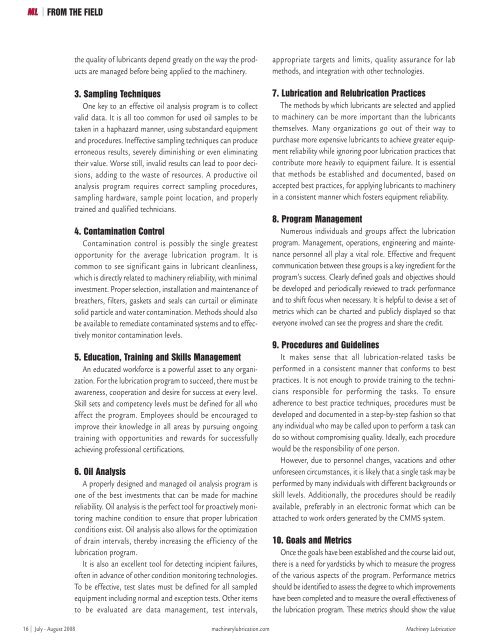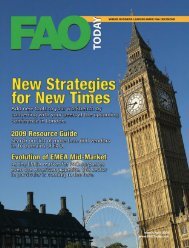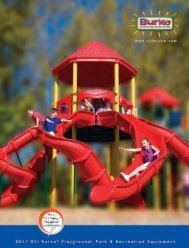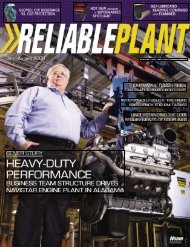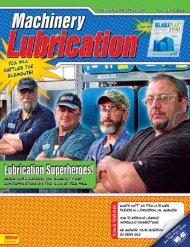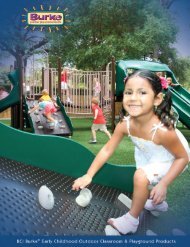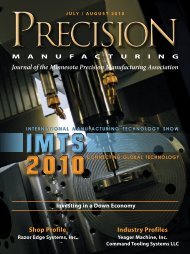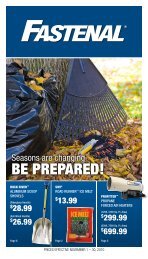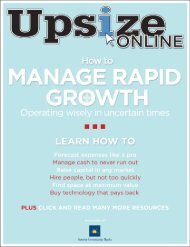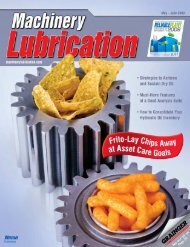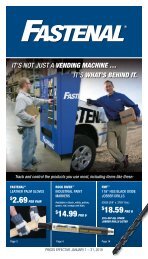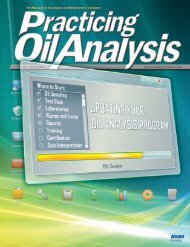Machinery Lubrication July August 2008
Machinery Lubrication July August 2008
Machinery Lubrication July August 2008
Create successful ePaper yourself
Turn your PDF publications into a flip-book with our unique Google optimized e-Paper software.
FROM THE FIELD<br />
the quality of lubricants depend greatly on the way the products<br />
are managed before being applied to the machinery.<br />
3. Sampling Techniques<br />
One key to an effective oil analysis program is to collect<br />
valid data. It is all too common for used oil samples to be<br />
taken in a haphazard manner, using substandard equipment<br />
and procedures. Ineffective sampling techniques can produce<br />
erroneous results, severely diminishing or even eliminating<br />
their value. Worse still, invalid results can lead to poor decisions,<br />
adding to the waste of resources. A productive oil<br />
analysis program requires correct sampling procedures,<br />
sampling hardware, sample point location, and properly<br />
trained and qualified technicians.<br />
4. Contamination Control<br />
Contamination control is possibly the single greatest<br />
opportunity for the average lubrication program. It is<br />
common to see significant gains in lubricant cleanliness,<br />
which is directly related to machinery reliability, with minimal<br />
investment. Proper selection, installation and maintenance of<br />
breathers, filters, gaskets and seals can curtail or eliminate<br />
solid particle and water contamination. Methods should also<br />
be available to remediate contaminated systems and to effectively<br />
monitor contamination levels.<br />
5. Education, Training and Skills Management<br />
An educated workforce is a powerful asset to any organization.<br />
For the lubrication program to succeed, there must be<br />
awareness, cooperation and desire for success at every level.<br />
Skill sets and competency levels must be defined for all who<br />
affect the program. Employees should be encouraged to<br />
improve their knowledge in all areas by pursuing ongoing<br />
training with opportunities and rewards for successfully<br />
achieving professional certifications.<br />
6. Oil Analysis<br />
A properly designed and managed oil analysis program is<br />
one of the best investments that can be made for machine<br />
reliability. Oil analysis is the perfect tool for proactively monitoring<br />
machine condition to ensure that proper lubrication<br />
conditions exist. Oil analysis also allows for the optimization<br />
of drain intervals, thereby increasing the efficiency of the<br />
lubrication program.<br />
It is also an excellent tool for detecting incipient failures,<br />
often in advance of other condition monitoring technologies.<br />
To be effective, test slates must be defined for all sampled<br />
equipment including normal and exception tests. Other items<br />
to be evaluated are data management, test intervals,<br />
appropriate targets and limits, quality assurance for lab<br />
methods, and integration with other technologies.<br />
7. <strong>Lubrication</strong> and Relubrication Practices<br />
The methods by which lubricants are selected and applied<br />
to machinery can be more important than the lubricants<br />
themselves. Many organizations go out of their way to<br />
purchase more expensive lubricants to achieve greater equipment<br />
reliability while ignoring poor lubrication practices that<br />
contribute more heavily to equipment failure. It is essential<br />
that methods be established and documented, based on<br />
accepted best practices, for applying lubricants to machinery<br />
in a consistent manner which fosters equipment reliability.<br />
8. Program Management<br />
Numerous individuals and groups affect the lubrication<br />
program. Management, operations, engineering and maintenance<br />
personnel all play a vital role. Effective and frequent<br />
communication between these groups is a key ingredient for the<br />
program’s success. Clearly defined goals and objectives should<br />
be developed and periodically reviewed to track performance<br />
and to shift focus when necessary. It is helpful to devise a set of<br />
metrics which can be charted and publicly displayed so that<br />
everyone involved can see the progress and share the credit.<br />
9. Procedures and Guidelines<br />
It makes sense that all lubrication-related tasks be<br />
performed in a consistent manner that conforms to best<br />
practices. It is not enough to provide training to the technicians<br />
responsible for performing the tasks. To ensure<br />
adherence to best practice techniques, procedures must be<br />
developed and documented in a step-by-step fashion so that<br />
any individual who may be called upon to perform a task can<br />
do so without compromising quality. Ideally, each procedure<br />
would be the responsibility of one person.<br />
However, due to personnel changes, vacations and other<br />
unforeseen circumstances, it is likely that a single task may be<br />
performed by many individuals with different backgrounds or<br />
skill levels. Additionally, the procedures should be readily<br />
available, preferably in an electronic format which can be<br />
attached to work orders generated by the CMMS system.<br />
10. Goals and Metrics<br />
Once the goals have been established and the course laid out,<br />
there is a need for yardsticks by which to measure the progress<br />
of the various aspects of the program. Performance metrics<br />
should be identified to assess the degree to which improvements<br />
have been completed and to measure the overall effectiveness of<br />
the lubrication program. These metrics should show the value<br />
16 <strong>July</strong> - <strong>August</strong> <strong>2008</strong> machinerylubrication.com <strong>Machinery</strong> <strong>Lubrication</strong>


